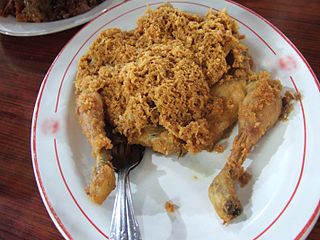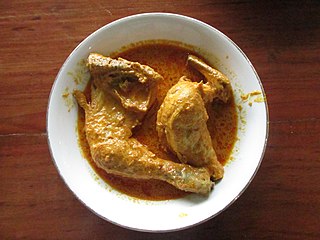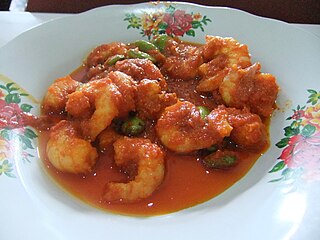
Indonesian cuisine is a collection of various regional culinary traditions that formed in the archipelagic nation of Indonesia. There are a wide variety of recipes and cuisines in part because Indonesia is composed of approximately 6,000 populated islands of the total 17,508 in the world's largest archipelago, with more than 1,300 ethnic groups.

Peranakan cuisine or Nyonya cuisine comes from the Peranakans, descendants of early Chinese migrants who settled in Penang, Malacca, Singapore and Indonesia, inter-marrying with local Malays. In Baba Malay, a female Peranakan is known as a nonya, and a male Peranakan is known as a baba. The cuisine combines Chinese, Malay, Javanese, South Indian, and other influences.

Javanese cuisine is the cuisine of Javanese people, a major ethnic group in Indonesia, more precisely the province of Central Java, Yogyakarta and East Java.

Sundanese cuisine is the cuisine of the Sundanese people of Western Java, and Banten, Indonesia. It is one of the most popular foods in Indonesia. Sundanese food is characterised by its freshness; the famous lalab eaten with sambal and also karedok demonstrate the Sundanese fondness for fresh raw vegetables. Unlike the rich and spicy taste, infused with coconut milk and curry of Minangkabau cuisine, the Sundanese cuisine displays the simple and clear taste; ranged from savoury salty, fresh sourness, mild sweetness, to hot and spicy.

Bumbu is the Indonesian word for a blend of spices and for pastes and it commonly appears in the names of spice mixtures, sauces and seasoning pastes. The official Indonesian language dictionary describes bumbu as "various types of herbs and plants that have a pleasant aroma and flavour — such as ginger, turmeric, galangal, nutmeg and pepper — used to enhance the flavour of the food."

Balinese cuisine is a cuisine tradition of Balinese people from the volcanic island of Bali. Using a variety of spices, blended with the fresh vegetables, meat and fish. Part of Indonesian cuisine, it demonstrates indigenous traditions, as well as influences from other Indonesian regional cuisine, Chinese and Indian. The island's inhabitants are predominantly Hindu and culinary traditions are somewhat distinct with the rest of Indonesia, with festivals and religious celebrations including many special foods prepared as the offerings for the deities, as well as other dishes consumed communally during the celebrations.

Minahasan cuisine or Manado cuisine is the cooking tradition of the Minahasan people of North Sulawesi, Indonesia. It is popularly known as "Manadonese cuisine" after Manado, the capital of the province, although other cities in Northern Sulawesi, such as Bitung, Tomohon and Tondano, are also known as Minahasan culinary hotspots. Manadonese cuisine is known for its rich variations in seafood, generous amount of spices, extra-hot condiments, exotic meats, and European-influenced cakes and pastries. Popular Manadonese dishes include tinutuan, cakalang fufu, cakalang noodle, paniki, chicken or various fish and seafood spiced in rica-rica or woku spices, chicken tuturuga, and brenebon.

Rica-rica is a type of Southeast Asian hot and spicy bumbu found in Minahasan cuisine and Gorontalo cuisine of Minahasa Peninsula, North Sulawesi, Indonesia.

Burasa is an Indonesian rice dumpling, cooked with coconut milk packed inside a banana leaf pouch. It is similar to lontong, but with a richer flavour acquired from the coconut milk. It is a delicacy of the Bugis and Makassar people of South Sulawesi. It is also a dish associated with the Bugis diaspora, notably in the Malaysian states of Johor, Selangor, Sabah, and Sarawak where there are large established communities. It is often consumed as a staple to replace steamed rice or ketupat, and a popular accompaniment to a rich dish of chicken braised with galangal.

Ayam goreng is an Indonesian and Malaysian dish consisting of deep-fried chicken in oil. Ayam goreng literally means "fried chicken" in Malay, Indonesian and also in many Indonesian regional languages. Unlike other countries, Indonesian fried chicken usually uses turmeric and garlic as its main ingredients rather than flour.

Ayam bakar is an Indonesian and Malay dish, consisting of charcoal-grilled chicken. Ayam bakar literally means "grilled chicken" in Indonesian and Malay.

Ikan goreng is a hot dish consisting of deep fried fish or other forms of seafood. Ikan goreng literally means "fried fish" in Indonesian and Malay languages.

Sambal is an Indonesian chili sauce or paste, typically made from a mixture of a variety of chilli peppers with secondary ingredients such as shrimp paste, garlic, ginger, shallot, scallion, palm sugar, and lime juice. Sambal is an Indonesian loanword of Javanese origin. It originated from the culinary traditions of Indonesia and is also an integral part of the cuisines of Singapore, Malaysia, Brunei, and Sri Lanka. It has also spread through overseas Indonesian populations to the Netherlands and Suriname.

Ikan bakar is an Indonesian and Malay dish, prepared with charcoal-grilled fish or other forms of seafood. Ikan bakar literally means "grilled fish" in Indonesian and Malay. Ikan bakar differs from other grilled fish dishes in that it often contains flavorings like bumbu, kecap manis, sambal, and is covered in a banana leaf and cooked on a charcoal fire.

Betutu is a Balinese dish of steamed or roasted chicken or duck in rich bumbu betutu. This highly seasoned and spiced dish is a popular dish in Bali and Lombok, Indonesia. An even spicier version is available using extra-spicy sauce made from uncooked (raw) onion slices mixed with red chili peppers and coconut oil.

Gulai is a class of spicy and rich stew commonly found in the Malay Archipelago. The main ingredients of the dish are usually poultry, goat meat, beef, mutton, various kinds of offal, fish, and seafood, as well as vegetables such as cassava leaves, unripe jackfruit, and banana stem.

Pindang refers to a cooking method in the Indonesian and Malay language of boiling ingredients in brine or acidic solutions. Usually employed to cook fish or egg, the technique is native to Sumatra especially in Palembang, but has spread to Java and Kalimantan. The term also could refer to a specific sour and spicy fish soup which employs seasonings like tamarind. Pindang has food preservation properties, which extends the shelf life of fish products.

Tinorangsak or tinoransak is an Indonesian hot and spicy meat dish that uses specific bumbu found in Manado cuisine of North Sulawesi, Indonesia. The most common meat used in tinorangsak is pork. However, other kind of meat such as beef, chicken or seafood might be used as well. Spices mixture includes chili pepper, shallot or onion, ginger, lime leaves, lemongrass, lime juice, cooking oil, and salt.

Udang balado or sambal goreng udang is a hot and spicy shrimp dish commonly found in Indonesian cuisine. It is made of shrimp, either peeled or unpeeled, stir-fried in hot and spicy sambal paste in a small amount of cooking oil.


















